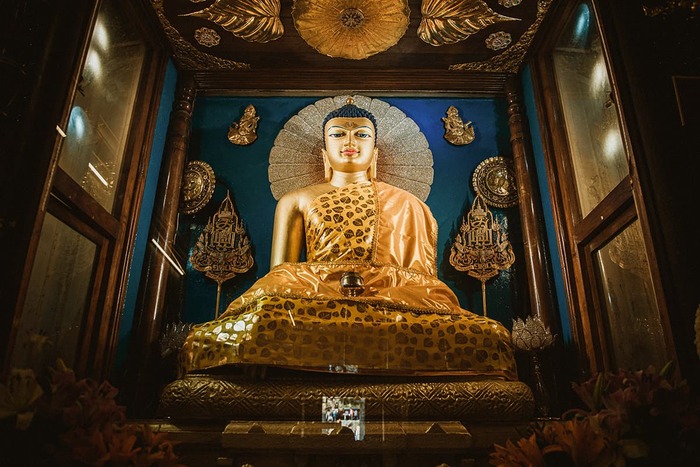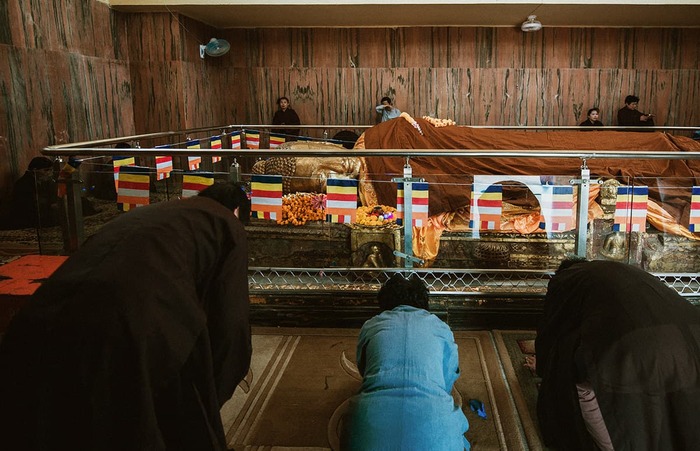
The Historical Buddha
According to most traditional biographies, the man who would later become the Buddha was born into the aristocratic Shakya clan in northern India in the 5th century BCE. He was given the name Siddhartha Gautama, and at the celebration of his birth, a wise hermit called Asita proclaimed that the young child would become either a great king or a great religious teacher. Siddhartha’s father, Shuddhodhana, was the chief of the Shakya clan and, desperate for his young son to follow in his footsteps, decided to shield his son from anything that might cause him to swerve from the path of becoming a great king.
The young Siddhartha was kept isolated in the family palace and offered every luxury possible: precious jewels and beautiful women, lotus ponds and delightful menageries. He was protected from any sort of misery or misfortune, as the sick and elderly were forbidden to enter the palace. Over time, Siddhartha excelled in his studies and in sports, and married Yasodhara, with whom he had a son, Rahula.
For almost 30 years, Siddhartha lived a life of luxury, but with a growing curiosity as to what might lay outside the palace walls. “If this land is to be mine,” he thought, “then surely I should see it and my people?” Eventually, Shuddhodhana arranged for his son to be taken on excursions out of the palace. The streets were cleaned, the sick and old people were hidden away, and Siddhartha was driven through the streets by his charioteer, Channa, as the local people waved and smiled. And yet, through the crowd, Siddhartha noticed a being, bent over and wrinkled, by the side of the road. Both amazed and shocked, he asked Channa what had happened to this poor creature. “What you see before you is an old person, a fate that awaits us all,” Channa replied. Further on, Siddhartha came across a sick person and a corpse, both further opening his eyes to the inevitable – yet totally normal – parts of life that would eventually touch him too.
Finally, he encountered a holy man, someone searching for liberation from suffering. These first three sights made Siddhartha realize that he had been deceived by his life in the palace, shielded from all suffering. The sight of the holy man awakened him to the possibility of searching for a way out of suffering.
It is unlikely that Siddhartha had never encountered the elderly or sick people before this, but it shows symbolically how he – and indeed, all of us – usually live our life ignoring suffering. Back at the palace, Siddhartha felt a great unease. He had lived a life of ease surrounded by his loved ones, but how could he now enjoy it or relax with the knowledge that one day, he and all of them would grow old, sick, and pass away? Desperate to find a way out for everyone, he escaped the palace one night to live the life of a wandering ascetic.
Siddhartha met many great teachers, and although under their guidance he attained very high levels of concentration through meditation, he was still dissatisfied as these meditative states didn’t lead to the end of suffering. He turned to ascetic practices, depriving his body of food and all physical comforts, and spending most of his time practicing meditation. Engaging in these practices for six years, his body became so thin that he resembled a skeleton covered in the thinnest layer of skin.
One day, sitting by the river, he overheard a teacher instructing a young child how to play an instrument: “The strings cannot be too loose, otherwise you can’t play the instrument. Likewise, they can’t be too tight, otherwise they will break.” With this, Siddhartha realized that his years of ascetic practice had not been of use. Just like his life of luxury in the palace, ascetic practices were an extreme that did not overcome suffering. The middle way between these extremes must be the answer, he thought.
At that moment, a young girl called Sujata passed by and offered Siddhartha some milk rice, his first proper food in six years. He ate, shocking his fellow ascetic friends, and went to sit underneath a fig tree. He decided there and then, “I will not rise from this seat until I have attained full awakening.” Under this tree, now known as the bodhi tree, Siddhartha attained full enlightenment and became known as the Buddha, the awakened one.
Soon after his enlightenment, the Buddha gave teachings on the four noble truths and eightfold path. For the next 40 years, he travelled across the northern Indian plains teaching the realizations he had attained to others. He founded a monastic order known as the Sangha, who would go on to spread the Buddha’s teachings throughout India and eventually, across Asia and the world.
The Buddha passed away at around the age of 80 in Kushinagar. Before doing so, he asked the Sangha whether they had any doubts or if there was anything within the teachings that needed clarification. Counseling his followers to rely on the Dharma and ethical self-discipline, he spoke his last words: “Behold, O monks, this is my last advice to you. All component things in the world are changeable. They are not lasting. Work hard to gain your own salvation.” With that, he lay on his right side and passed away.

What Are Buddhas?
We’ve seen who the historical Buddha was, but what does it actually mean to be a Buddha?
Simply, a Buddha is someone who has awakened. Buddhas have woken up from a deep sleep. This isn’t the kind of deep sleep we might have after partying all night, but it’s the deep sleep of confusion that pervades every moment of our lives; confusion about how we really exist, and in fact how everything really exists.
Buddhas are not gods, and they aren’t creators either. All Buddhas start out just like us, filled with confusion, disturbing emotions and lots of problems. But, by slowly following the path of compassion and wisdom, and by working hard to develop these two positive qualities, it is possible to attain enlightenment for oneself.
Buddhas have three main qualities:
- Wisdom – A Buddha has no mental blocks, so they fully and correctly understand everything, especially how to help others.
- Compassion – Due to the wisdom above, seeing that we are all connected with each other, Buddhas have great compassion and know that they’re capable of helping everyone. Wisdom without compassion might make a person very educated, but they’re not much use to society. Compassion is what moves them to work for the benefit of everyone. That’s why Buddhas generate this second quality, to make a connection with all of us.
- Abilities – With the two qualities of knowing how to eliminate suffering, and having the strong wish to help others, Buddhas have the actual power and ability to really benefit others, by teaching us the paths to enlightenment in a variety of skillful ways.
Buddhas understand that just as they don’t want to suffer, nobody else wants problems either. Everybody wants to be happy. So, Buddhas work not just for themselves, but for every being in the universe. They care for others as much as they care for themselves.
Moved by their incredibly strong compassion, they teach the solution to eliminate all suffering, which is called wisdom – the clarity of mind to discriminate correctly between reality and fiction. With this wisdom, we can finally get rid of all negative things: all the confusion, selfishness, and negative emotions. We too can become perfect Buddhas, and experience complete inner peace.
Summary
Buddhas are perfect teachers who know exactly how to help us with their skillful methods. They are compassionate and always ready and willing to help us, by setting us on the right track.
Like Siddhartha, we too are often blind to the sufferings of the world. But no matter how much we try to avoid or ignore it, old age, sickness, and death will come to us all. The Buddha’s life story inspires us to see that by facing and understanding the realities of suffering just as he did, we are also able to free ourselves from all of the frustration that we experience in life. His life and teachings remind us that we must try our best to overcome our destructive emotions and confusion so that, just like him, we can work to benefit all beings ourselves.